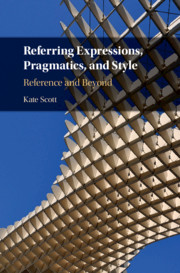
-
Select format
-
- Publisher:
- Cambridge University Press
- Publication date:
- October 2019
- November 2019
- ISBN:
- 9781316822845
- 9781107177574
- 9781316628478
- Dimensions:
- (228 x 152 mm)
- Weight & Pages:
- 0.4kg, 198 Pages
- Dimensions:
- (229 x 152 mm)
- Weight & Pages:
- 0.305kg, 200 Pages
- Subjects:
- Language and Linguistics, Semantics and Pragmatics
You may already have access via personal or institutional login- Subjects:
- Language and Linguistics, Semantics and Pragmatics
Book description
Reference is a major theme in the study of language and language use. Providing a relevance-theoretic account of reference resolution, this book develops our understanding of procedurally encoded meaning by exploring its function and role in reference resolution. A range of referring expressions are discussed, including definite descriptions, demonstratives and pronouns. Existing work on the pragmatics of reference has largely focused on how reference is resolved. However, speakers can do much more than just secure reference when they use a referring expression. A speaker's choice of expression might communicate information about their attitudes and their emotions, and referring expressions can also be used to create stylistic and poetic effects. The analyses in this book widen the focus to consider these broader effects, and the discussions and arguments presented take seriously the idea that referring expressions can contribute to meaning and communication in a way that goes beyond reference.
Reviews
‘In all, Scott's first monograph is a valuable contribution to the study of reference and the first of its kind which brings together all the various and disparate literatures on a seemingly simple yet astonishingly intricate topic in the study of utterance comprehension. It should be praised in particular for its treatment of stylistic effects, which is where it contributes the most original argument.’
Julia Kolkmann Source: Journal of Pragmatics
Contents
Metrics
Altmetric attention score
Full text views
Full text views help Loading metrics...
Loading metrics...
* Views captured on Cambridge Core between #date#. This data will be updated every 24 hours.
Usage data cannot currently be displayed.
Accessibility standard: Unknown
Why this information is here
This section outlines the accessibility features of this content - including support for screen readers, full keyboard navigation and high-contrast display options. This may not be relevant for you.
Accessibility Information
Accessibility compliance for the PDF of this book is currently unknown and may be updated in the future.


